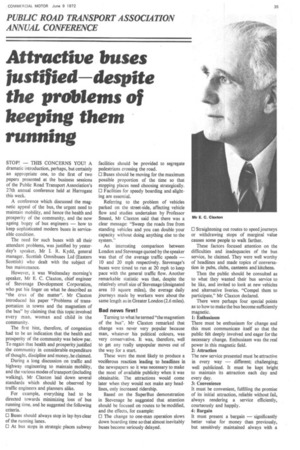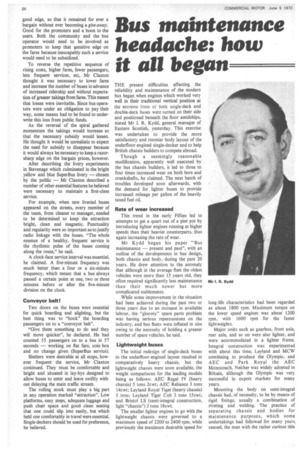Attractive buses justified despite the problems of keeping them running
Page 37

Page 38

If you've noticed an error in this article please click here to report it so we can fix it.
STOP! — THIS CONCERNS YOU! A dramatic introduction, perhaps, but certainly an appropriate one, to the first of two papers presented at the business sessions of the Public Road Transport Association's 27th annual conference held at Harrogate this week.
A conference which discussed the magnetic appeal of the bus, the urgent need to maintain mobility, and hence the health and prosperity of the community, and the now ageing bogey of bus engineers — how to keep sophisticated modern buses in serviceable condition.
The need for such buses with all their attendant problems, was justified by yesterday's speaker, Mr I. R. Kydd, general manager, Scottish Omnibuses Ltd (Eastern Scottish) who dealt with the subject of bus maintenance.
However, it was Wednesday morning's speaker, Mr E. C. Claxton, chief engineer of Stevenage Development Corporation, who put his fmger on what he described as "the crux of the matter". Mr Claxton introduced his paper "Problems of transportation in towns and the magnetism of the bus" by claiming that this topic involved every man, woman and child in the community.
The first hint, therefore, of congestion had to be an indication that the health and prosperity of the community was below par. To regain that health and prosperity justified the community in considerable expenditure of thought, discipline and money, he claimed.
During a long discussion on traffic and highway engineering to maintain mobility, and the various modes of transport (including walking), Mr Claxton laid down several standards which should be observed by traffic engineers and planners alike.
For example, everything had to be directed towards minimizing loss of bus running time, and he suggested the following criteria.
0 Buses should always stop in lay-bys clear of the running lanes.
D At bus stops in strategic places subway facilities should be provided to segregate pedestrians crossing the road.
0 Buses should be moving for the maximum possible proportion of the time so that stopping places need choosing strategically. 0 Facilities for speedy boarding and alighting are essential.
Referring to the problem of vehicles parked on the street-side, affecting vehicle flow and studies undertaken by Professor Smeed, Mr Claxton said that there was a clear message: "Sweep the roads free from standing vehicles and you can double your capacity without doing anything else to the system."
An interesting comparison between London and Stevenage quoted by the speaker was that of the average traffic speeds — 10 and 20 mph respectively. Stevenage's buses were timed to run at 20 mph to keep pace with the general traffic flow. Another remarkable statistic was that, despite the relatively small size of Stevenage (designated area 10 square miles), the average daily journeys made by workers were about the same length as in Greater London (2.6 miles).
Bad news first!
Turning to what he termed "the magnetism of the bus", Mr Claxton remarked that change was never very popular because man, whatever his political colours, was very conservative. It was, therefore, well to get any really unpopular moves out of the way for a start.
These were the most likely to produce a vociferous reaction leading to headlines in the newspapers so it was necessary to make the most of available publicity when it was obtainable. The attractions would come later when they would not make any headlines, only increased ridership.
Based on the SuperBus demonstration in Stevenage he suggested that attention should be focused on routes to be modified, and the effects, for example: O The change to one-man operation slows down boarding time so that almost inevitably buses become seriously delayed. 0 Straightening out routes to speed journeys or withdrawing stops of marginal value causes some people to walk farther.
These factors focused attention on the difficulties and inadequacies of the bus service, he claimed. They were well worthy of headlines and made topics of conversation in pubs, clubs, canteens and kitchens.
Then the public should be consulted as to what they wanted their bus service to be like, and invited to look at new vehicles and alternative liveries. "Compel them to participate," Mr Claxton declared.
There were perhaps four special points as to how to make the bus become sufficiently magnetic.
1: Enthusiasm There must be enthusiasm for change and this must communicate itself so that the public felt deeply involved and eager for the necessary change. Enthusiasm was the real power in this magnetic field.
2: Attraction The new service presented must be attractive in every way — different; challenging; well publicized. It must be kept bright to maintain its attraction each day and every day.
3: Convenience It must be convenient, fulfilling the promise of its initial attraction, reliable without fail, always rendering a service efficiently, courteously and happily.
4: Bargain It must present a bargain — significantly better value for money than previously, but sensitively maintained always with a
good edge, so that it remained for ever a bargain without ever becoming a give away. Good for the promoters and a boon to the users. Both the community and the bus operator would need to be involved as promoters to keep that 4ensitive edge on the fares because inescapably such a service would need to be subsidized.
To reverse the repetitive sequence of rising costs, higher fares, fewer passengers, less frequent services, etc, Mr Claxton thought it was necessary to lower fares and increase the number of buses in advance of increased ridership and without expectation of greater takings from fares. This meant that losses were inevitable. Since bus operators were under an obligation to pay their way, some means had to be found to underwrite this loss from public funds.
As the reversal of the spiral gathered momentum the takings would increase so that the necessary subsidy would lessen. He thought it would be unrealistic to expect the need for subsidy to disappear because it would always be necessary to keep a razorsharp edge on the bargain prices, however.
After describing the livery experiments in Stevenage which culminated in the bright yellow and blue SuperBus livery — chosen by the public — Mr Claxton described a number of other essential features he believed were necessary to maintain a first-class service.
For example, when new liveried buses appeared on the streets, every member of the team, from cleaner to manager, needed to be determined to keep the attraction bright, clean and magnetic. Punctuality and regularity were so important as to justify radio linkage with the buses. "The whole essence of a healthy, frequent service is the rhythmic pulse of the buses coming along the route," he said.
A clock-face service interval was essential, he claimed. A five-minute frequency was much better than a four or a six-minute frequency, which meant that a bus always passed a certain point at one, two or three minutes before or after the five-minute division on the clock.
Conveyor belt!
Two doors on the buses were essential for quick boarding and alighting, but the best thing was to "hook" the boarding passengers on to a "conveyor belt".
"Give them something to do and they will move quicker", he declared. He had counted 55 passengers on to a bus in 57 seconds — working on flat fare, coin box and no change given (SuperBus service).
Shelters were desirable at all stops, however frequent the service, Mr Claxton continued. They must be comfortable and bright and situated in lay-bys designed to allow buses to enter and leave swiftly without delaying the main traffic stream.
The rolling stock must play a big part in any operation marked "attraction". Low platforms, easy steps, adequate luggage and push chair space and good clean seating that one could slip into easily, but which held one comfortably in travel were essential. Single-deckers should be used for preference, he believed.




































































































